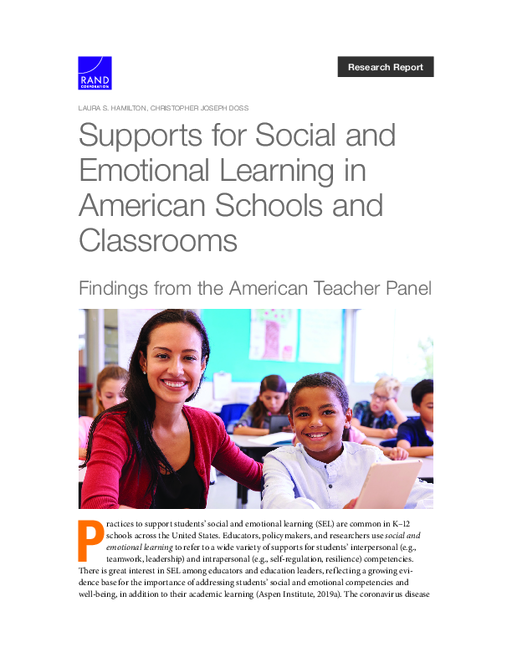- Author(s)
- Laura S. Hamilton and Christopher Joseph Doss
- Publisher(s)
- RAND Corporation
- DOI Link
- https://doi.org/10.7249/RRA397-1
Research Approach
The research presents results from a spring 2019 survey given to a nationally representative sample of K–12 teachers. Researchers fielded the survey to 1,998 teachers, with 1,238 responding, for a completion rate of 62 percent.
Researchers used probability-based sampling to produce a picture of practices, supports, and conditions that reflect a whole-school, systemic approach to SEL. The final sample was weighted to ensure that it was nationally representative in terms of several areas. That included teacher characteristics (e.g., years of teaching, race/ethnicity) and school characteristics (e.g., geographic location, enrollment, student racial/ ethnic composition).
Sample and Data
The research was conducted via the American Teacher Panel (ATP), a nationally representative panel of U.S. public school teachers recruited by probabilistic sampling methods. Teachers were recruited from three groups: urban elementary schools, nonurban elementary schools, and secondary schools (grades 6–12).
Most of the questions on the survey were drawn from surveys that RAND Corporation researchers gave to teachers, as part of research on The Wallace Foundation’s Partnerships for Social and Emotional Learning Initiative. The questions addressed the five contextual factors. They included teacher beliefs, well-being, professional development [PD], school context, and standards and data use. They also looked at a variety of classroom and school SEL practices. That included use of SEL 3 curricula, integration of SEL into academic instruction, and practices to create positive school-wide climate.
Researchers partnered with the Yale Center for Emotional Intelligence (YCEI) to include their measure of well-being, the Affective Experiences Scale (AES). They also asked questions about job satisfaction and burnout, drawn from the University of Chicago Consortium on School Research.

